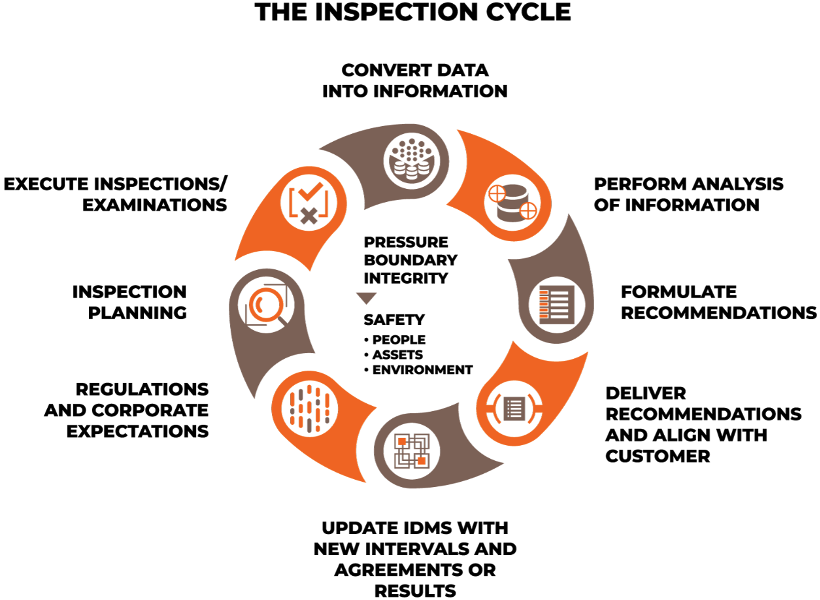What is in a Recommendation? A Guide to Inspection Recommendations in the Mechanical Integrity Field

Introduction
Inspection recommendations are vital for maintaining safety, reliability, and efficiency within the mechanical integrity (MI) field. These recommendations distill the findings of detailed examinations, inspections, and evaluations into actionable steps, ensuring that risks are mitigated, compliance is maintained, and assets are managed effectively.
In this comprehensive guide, we will delve into what makes an effective inspection recommendation, the purpose it serves, the elements it should include, and best practices for formulating them. Additionally, we’ll explore the common challenges faced in this process and the significant impact of high-quality recommendations on mechanical integrity programs. By the end, you’ll gain a deeper understanding of how to craft recommendations that are clear, actionable, and impactful.
It is important to recognize and accept that recommendations are part and parcel of a larger concerted inspection cycleThe Purpose of an Inspection Recommendation
Inspection recommendations are not just about addressing problems; they are strategic tools that align safety and compliance requirements with operational goals. Their purpose can be broken down into the following key areas.
Risk Mitigation and Risk Drivers
One of the primary purposes of an inspection recommendation is to proactively identify risk drivers and mitigate risks addressing potential safety and operational issues. In doing so, organizations can prevent incidents that could lead to equipment failure, environmental harm, or loss of life. Once risk drivers are accurately identified, effective strategies are developed to mitigate the unacceptable risks.
Regulatory Compliance
Regulations and industry standards, such as those set forth by API, ASME, and OSHA, require organizations to demonstrate their commitment to safety and environmental protection. Inspection recommendations play a key role in meeting these requirements by ensuring that assets are maintained in compliance with applicable codes and standards.
Asset Lifecycle Management
Inspection recommendations help organizations make informed decisions about the repair, replacement, or continued use of assets. By evaluating the condition of equipment and projecting future performance, these recommendations extend the usable life of assets while optimizing maintenance budgets. Inspection also supplies necessary information to engineers who must perform fitness-for-service (FFS) assessments of equipment. Inspection findings indicate which equipment may be candidates for FFS assessments.
Cost Efficiency
Unplanned downtime and emergency repairs are costly, both in terms of direct expenses and lost productivity. Recommendations that identify and address issues early can significantly reduce these costs, ensuring more predictable and manageable maintenance expenditures.
Operational Excellence
Inspection recommendations also drive continuous improvement in operational processes. By identifying and addressing recurring issues, organizations can enhance efficiency and reliability over time.
Key Elements of an Inspection Recommendation
An effective inspection recommendation is more than a statement of findings; it is a roadmap for action. Below are the essential elements that should be included.
1. Observation
The foundation of any recommendation lies in a detailed and accurate description of the findings from the examination and inspection.
- Specificity: Clearly describe the observed issue, including its location, affected components, and type (e.g., corrosion, cracking, wear).
- Supporting Evidence: Provide documentation such as photographs, nondestructive examination (NDE) results, and historical inspection records.
- Context: Relate the observations to operating conditions and service history to provide a comprehensive understanding.
2. Assessment
Once the issue is observed, it must be analyzed to determine its significance.
- Technical Analysis: Use applicable codes and standards (e.g., API 579 for fitness-for-service evaluations) to assess the condition.
- Criticality: Determine the severity of the issue by evaluating its impact on equipment performance, safety, and reliability (e.g., use approved risk matrix)
- Comparison to Baselines: Compare current findings with historical data to identify trends or deviations.

3. Risk Evaluation
A thorough evaluation of risk helps prioritize recommendations and allocate resources effectively.
- Consequence Analysis: Identify the potential outcomes of inaction, such as equipment failure, safety incidents, or environmental damage.
- Probability of Failure: Assess the likelihood of the issue progressing to a failure state under current operating conditions.
- Risk Ranking: Use frameworks such as Risk-Based inspection (RBI) to prioritize recommendations based on their risk level.
4. Recommended Action
This is the core of the recommendation and provides clear guidance on addressing the observed issue.
- Actionable Steps: Detail specific actions, such as repairs, replacements, monitoring, or operational adjustments.
- Justification: Objectively explain why the recommended action is appropriate, referencing technical data and risk analysis.
- Urgency: Indicate the timeframe for action—whether immediate, short-term, or long-term.
5. Supporting Documentation
Recommendations should be substantiated with relevant documentation to enhance credibility and facilitate implementation.
- Codes and Standards: Reference the applicable industry guidelines that support the recommendation (e.g., API 510, API 570, API 653).
- Inspection Data: Include details such as NDE results, wall thickness measurements, defect characteristics, and engineering calculations.
- Historical Records: Provide context by incorporating past inspection reports and performance data.
6. Cost and Feasibility
Practicality is a key consideration in ensuring recommendations are implemented
- Cost Estimate: Provide an estimate of costs associated wit the recommended action, including materials, labor, and potential downtime. Work with peer and support departments such as Operations, Maintenance, and Procurement to gather the right information.
- Feasibility Analysis: Assess the operational impact and resource availability to determine the practicality of the recommendation. Take care here not to succumb to inconvenience to other departments. Safety of people, assets, and the environment fi rst over everything else.
- Alternative Solutions: Where applicable, suggest alternative approaches with a comparison of their pros and cons (e.g., creating a technically reverent solution to help the process unit or pressure equipment make it to the next scheduled maintenance opportunity).
7. Follow-Up Requirements
Recommendations often require ongoing monitoring and verification to ensure effectiveness.
- Future Inspections: Specify the frequency and scope of follow-up inspections. Assure it is safe to perform the follow-up examination or inspections.
- Monitoring Parameters: Identify key indicators to track, such as corrosion rates or crack propagation.
- Accountability: Assign responsibility for implementing and monitoring the recommendation. Strive to use repeatable NDE personnel, procedures, and methods and techniques to run the surveillance. Consistency is important in this step.
Challenges and Pitfalls
While recommendations are critical, they are not without challenges. Common pitfalls are explained below.
Vagueness
Recommendations that lack specificity can lead to confusion and inaction. Ensure the issue and required actions are described clearly and in detail. To mitigate vagueness, clearly explain what happened and how it happened in short form.
Lack of Prioritization
Failure to rank issues by urgency can result in misallocated resources and neglected critical issues. When resources are diverted to lower-priority tasks, more pressing concerns may be overlooked, leading to increased risk of equipment failure or safety incidents. This is especially problematic in environments where budgets and personnel are limited, as addressing the wrong priorities can compound long-term risks.
Poor Communication
Misalignment between inspection teams, engineers, and decision-makers can hinder the effective implementation of recommendations. Ensure clear and open communication at all stages. Here is where most recommendations die. Inspection teams and engineers should agree and be in lock step internally before contacting the customer (Operations). Stakeholders may shy away from recommendations where the group providing the recommendation does not agree with one another. This can cause unneeded recycling and loss of reputation.
Clash with Operational Priorities
Operational priorities often conflict with inspection recommendations, particularly when immediate actions may disrupt production schedules or require significant downtime. However, a recommendation must stand firm, grounded in technical integrity and safety considerations. If operations refuse to implement a recommendation, they must explicitly accept and document the associated risk. It is critical to never reverse-engineer or dilute the right recommendation under pressure from operations or management. Doing so undermines the integrity of the inspection process and exposes the organization to unacceptable risks.
Best Practices for Formulating Recommendations
High-quality recommendations are clear, actionable, and aligned with organizational goals. Below are best practices for crafting them:
- Clarity and Precision
- Use clear, concise language to avoid ambiguity. Avoid slang –the recommendation may travel so make it professional.
- Ensure the recommendation is specific and actionable.
- Contextual Relevance
- Tailor recommendations for the unique conditions and requirements of the asset and facility.
- Generate recommendations that return the pressure equipment to as built condition first. Other options can include temporary repairs supported by the management of change process.
- Consistency
- Follow a standardized format and structure to ensure uniformity across recommendations.
- Reference industry standards and organizational guidelines consistently.
- Prioritization
- Use a risk-based approach to rank recommendations by their urgency and impact.
- Clearly communicate the rationale for prioritization.
- Collaboration
- Involve key stakeholders, including inspection teams, engineers, and operations personnel, in the recommendation process.
- Ensure alignment and buy-in from all parties responsible for implementation.
Conclusion
Inspection recommendations represent more than technical evaluations; they are strategic pillars that uphold safety, compliance, and operational excellence. Well-formulated recommendations guide organizations in mitigating risks, optimizing asset performance, and extending equipment lifespan, all while adhering to industry standards and regulations.
The strength of a recommendation lies in its clarity, feasibility, and alignment with organizational goals. By consistently prioritizing safety and integrity over short-term operational pressures, organizations can ensure their decisions are resilient and forward-looking. Quality recommendations are not just about addressing present issues but building a culture of accountability and continuous improvement.
Partner with Dynamis for an innovative and effective AIM program tailored to your success.
- Minimize wear and tear with predictive maintenance strategies to extend asset life
- Reduce risk exposure for personnel and the environment to enhance safety
- Decrease unplanned downtime and maximize asset availability to optimize costs
- Meet and exceed international standards such as API, ASME, and ISO to achieve compliance
CLIENTS + STRATEGIC PARTNERSHIPS



.png)
.jpg)


